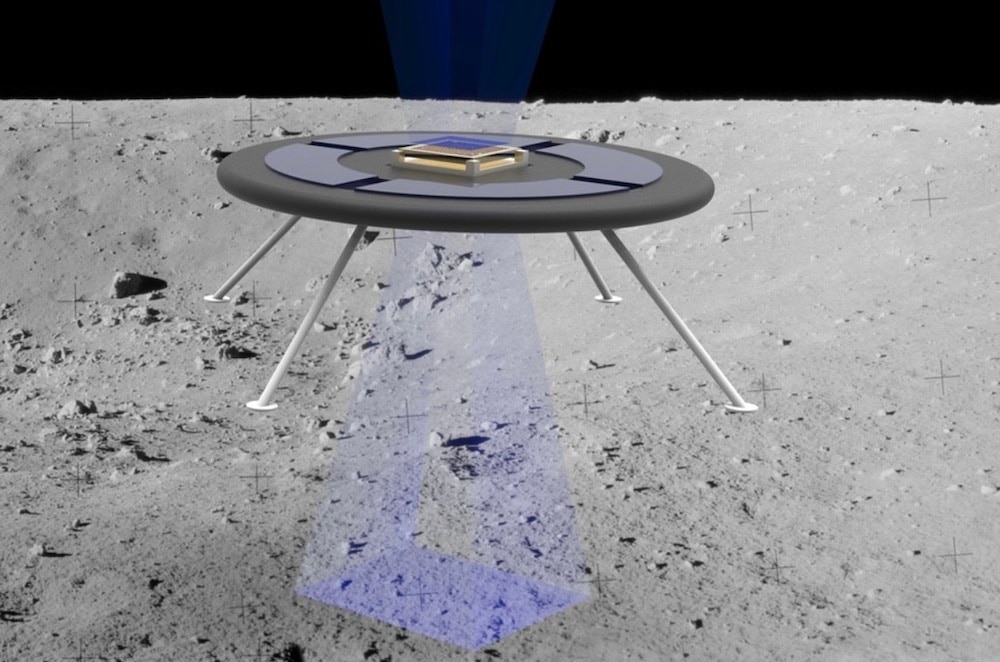Create a free profile to get unlimited access to exclusive videos, sweepstakes, and more!
Flying saucer-like rover can levitate by using electricity on the Moon’s surface
The design isn't just for extra cool points; this ion-powered flying saucer is the future of rovers.

It’s often UFOs that tend to appear in the form of flying saucers, but we might be the ones sending something that looks like a prop from War of the Worlds into space soon.
The retro-futuristic design of MIT’s hovering rover isn’t just for extra cool points. This spacecraft is designed to blast out a charge that repels the same charge on the lunar surface so it can levitate, a major advantage when it can just fly over uneven and sometimes perilous terrain instead of a rover that might crash to its doom. Imagine a future in which rovers can just whiz over anything dangerous instead of dying a slow and painful death like Opportunity.
It hasn’t yet taken off for the Moon, but the prototype designed by Oliver Jia-Richards, Paulo Lozano, and their team of aerospace engineers at MIT — who recently published a study in JSR — seems to have a positive outlook. The two-pound spacecraft (not much bigger than a CubeSat) uses ion beams to charge itself and turn up the charge on the lunar surface. An ion boost should be enough to keep it hovering right above the surface of not only the Moon, but eventually larger asteroids like Psyche.
Of course, a flying saucer that can get itself to levitate only looks like it’s relaxing and hanging out. Developing and testing such a thing is not so easy with Earth’s gravity in the way.
“The greatest challenge was dealing with Earth’s gravitational pull,” Jia-Richards told SYFY WIRE. “Our concept is intended to be used in low-gravity environments, and while we can simulate other aspects of the lunar environment (like the vacuum of space) here on Earth, we can’t just turn off Earth’s gravity.”
So how would this hovercraft stay above ground? Its wings are Mylar — the same stuff those shiny balloons you see in every party store are made of — which naturally has the same charge as the surfaces of airless bodies like the Moon or Psyche or Ryugu. Bodies like this accumulate an electric field from exposure to particles from the Sun and whatever plasma is floating around. The Moon has built up a charge that could already send dust flying over 3 feet above the surface. Because similarly charged surfaces repel each other, the craft should levitate.
The ionic design of the rover uses high voltage, but low electrical power. Those things that look like legs in the concept (above) are actual ion thrusters. These thrusters, or ionic-liquid ion sources, are directly connected to a source of ionic liquid, in this case molten salt. Just add voltage and the thrusters zap the surface below the ion beams. This is how it generates its own charge and a charge on the body it is directly above. Technically, you can transfer more charge by amping up the voltage, but at least for now, the team does not need those kinds of charges.
This is still a work in progress. If actual flying saucers are going to someday glide over craters and crags and mountains, they will need high-altitude adjustments to survive.
“Our model currently assumes that the vehicle and the surface are very close together,” said Jia-Richards. “This ignores how the force produced due to charging actually changes based on the position of the vehicle. In order to improve the model, we need to account for how the force produced by the interacting charges will change depending on the position of the vehicle.”
The reason these effects are not the greatest concern right now is that the researchers just wanted to prove that the levitating rover could go from concept to prototype. Now that they have been able to get the basics down and prove it works, the proto will receive upgrades so it will be able to handle whatever it faces out there. The only real way to be sure that it can carry out its mission on the Moon is to actually send it there. Though it isn’t there yet, Jia-Richards is optimistic about this un-rover-like rover and looks forward to it launching someday.
“We can build our confidence in the concept by performing experiments and attempting to recreate the lunar environment,” he said. “If we do that, then we can have reason to believe that the concept would work on the Moon.”


























